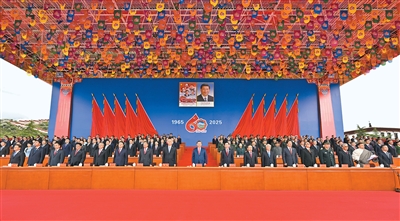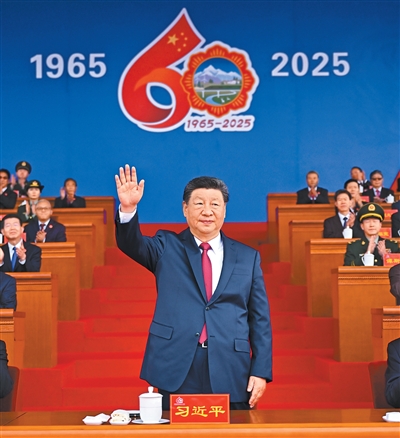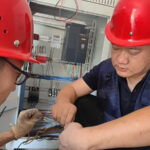Central Committee of the Communist Party of China, Standing Committee of the National People’s Congress, State Council, National Committee of the Chinese People’s Political Consultative Conference, and Central Military Commission Send Congratulatory Message
Xi Jinping Attends the Assembly
Wang Huning Attends and Delivers a Speech, Cai Qi Attends
|
On the morning of August 21, around 20,000 cadres and people from various ethnic groups and sectors in Tibet gathered joyfully at the Potala Palace Square in Lhasa to warmly celebrate the 60th anniversary of the establishment of the Tibet Autonomous Region. Xi Jinping, General Secretary of the Central Committee of the Communist Party of China, President of the State, and Chairman of the Central Military Commission, attended the celebration assembly. |
 |
|
On the morning of August 21, around 20,000 cadres and people from various ethnic groups and sectors in Tibet gathered joyfully at the Potala Palace Square in Lhasa to warmly celebrate the 60th anniversary of the establishment of the Tibet Autonomous Region. Xi Jinping, General Secretary of the Central Committee of the Communist Party of China, President of the State, and Chairman of the Central Military Commission, attended the celebration assembly. Wang Huning and Cai Qi attended the assembly. |
LHASA — Sixty years of hard work through wind and rain, six decades of tremendous changes on the snowy plateau. On the morning of the 21st, around 20,000 cadres and people from various ethnic groups and sectors in Tibet gathered joyfully at the Potala Palace Square in Lhasa to warmly celebrate the 60th anniversary of the establishment of the Tibet Autonomous Region. Xi Jinping, General Secretary of the Central Committee of the Communist Party of China, President of the State, and Chairman of the Central Military Commission, attended the celebration assembly.
Wang Huning, Member of the Standing Committee of the Political Bureau of the CPC Central Committee, Chairman of the National Committee of the Chinese People’s Political Consultative Conference, and Head of the Central Delegation, attended and delivered a speech. Cai Qi, Member of the Standing Committee of the Political Bureau of the CPC Central Committee and Director of the General Office of the CPC Central Committee, attended.
The ancient city of Lhasa was adorned with colorful flags, filled with a festive atmosphere. Under the majestic Potala Palace, a grandstand in Tibetan style was set up. The national emblem of the People’s Republic of China and the banner reading «Celebration Assembly for the 60th Anniversary of the Tibet Autonomous Region» were prominently displayed above the grandstand. The background wall featured the celebration emblem and the numbers «1965» and «2025,» with ten red flags on both sides. In the Potala Palace Square opposite the grandstand, people of various ethnic groups dressed in festive attire gathered from all directions, waving red flags in their hands, creating a sea of joy.</p


